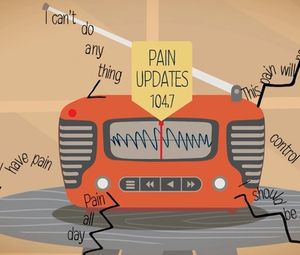
Cognitive Defusion
Learning to create distance from your thoughts takes practice
Skip to main content

Learning to create distance from your thoughts takes practice
Step 1: Listen to the audio recordings. Each recording demonstrates a different cognitive defusion strategy.
Start by identifying a thought you have about pain or a thought you have when you are experiencing pain: for example, ‘this pain is never going to get better’. Let yourself engage with this thought as it is now. Repeat it to yourself in your head and out loud. Notice you how feel in this moment. Now, repeat this thought with the lead, “I’m having the thought that this pain is never going to get better.” To further de-fuse from this thought, take another step back and repeat with the lead, “I notice I’m having the thought that this pain is never going to get better” Now, do you notice a mental shift? It may be subtle. Take a moment to reflect on this different way of experiencing this thought. This will take some practice and repetition. Try practicing this exercise with the different thoughts you notice about pain or that are causing you distress when you are in pain.
Start by identifying a thought you have about pain or a thought you have when you are experiencing pain: for example, ‘I can’t stand it anymore’. Let yourself engage with this thought as it is now. Repeat it to yourself in your head and out loud. Notice you how feel in this moment. Now, repeat this thought aloud several times very slowly, [read very slowly] “I can’t stand it anymore.” [read again very slowly] “I can’t stand it anymore.” Keep repeating your thought aloud very slowly until it sounds different to you. Notice the thought as a series of sounds, to which meaning can be attached, or not. Now, do you notice a mental shift? It may be subtle. Take a moment to reflect on this different way of experiencing this thought. This will take some practice and repetition. Try practicing this exercise with the different thoughts you notice about pain or that are causing you distress when you are in pain.
Start by identifying a thought you have about pain or a thought you have when you are experiencing pain: for example, ‘I’m afraid the pain will get worse’. Let yourself engage with this thought as it is now. Repeat it to yourself in your head and out loud. Notice you how feel in this moment. Now, repeat this thought aloud several times very fast, [read very quickly] “I’m afraid the pain will get worse.” [read several times very quickly] “I’m afraid the pain will get worse.” Keep repeating your thought aloud very quickly until it begins to lose its meaning. Notice the thought as a series of sounds, to which meaning can be attached, or not. Now, do you notice a mental shift? It may be subtle. Take a moment to reflect on this different way of experiencing this thought. This will take some practice and repetition. Try practicing this exercise with the different thoughts you notice about pain or that are causing you distress when you are in pain.
Start by identifying a thought you have about pain or a thought you have when you are experiencing pain: for example, ‘This is terrible’. Let yourself engage with this thought as it is now. Repeat it to yourself in your head and out loud. Notice you how feel in this moment. Now, repeat this thought aloud several times in a silly voice, [read in a silly voice] “This is terrible.” [read a few more times in a silly voice] “This is terrible.” Keep repeating your thought aloud with a funny or strange tone or inflection. As you keep repeating, notice the thought as a series of sounds, to which meaning could be attached, or not. Now, do you notice a mental shift? It may be subtle. Take a moment to reflect on this different way of experiencing this thought. This will take some practice and repetition. Try practicing this exercise with the different thoughts you notice about pain or that are causing you distress when you are in pain.
Step 1: Each day, try to identify the thoughts you are having when you are in pain, or thoughts you have about pain.
Step 2: Once you’ve identified the thought, try out some of the cognitive defusion strategies (I’m having the thought that, very slow, very fast, silly voice) and write down what you noticed.Over time you will find the strategies that best help you to get some distance from your thoughts.